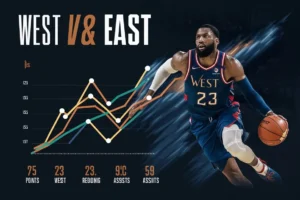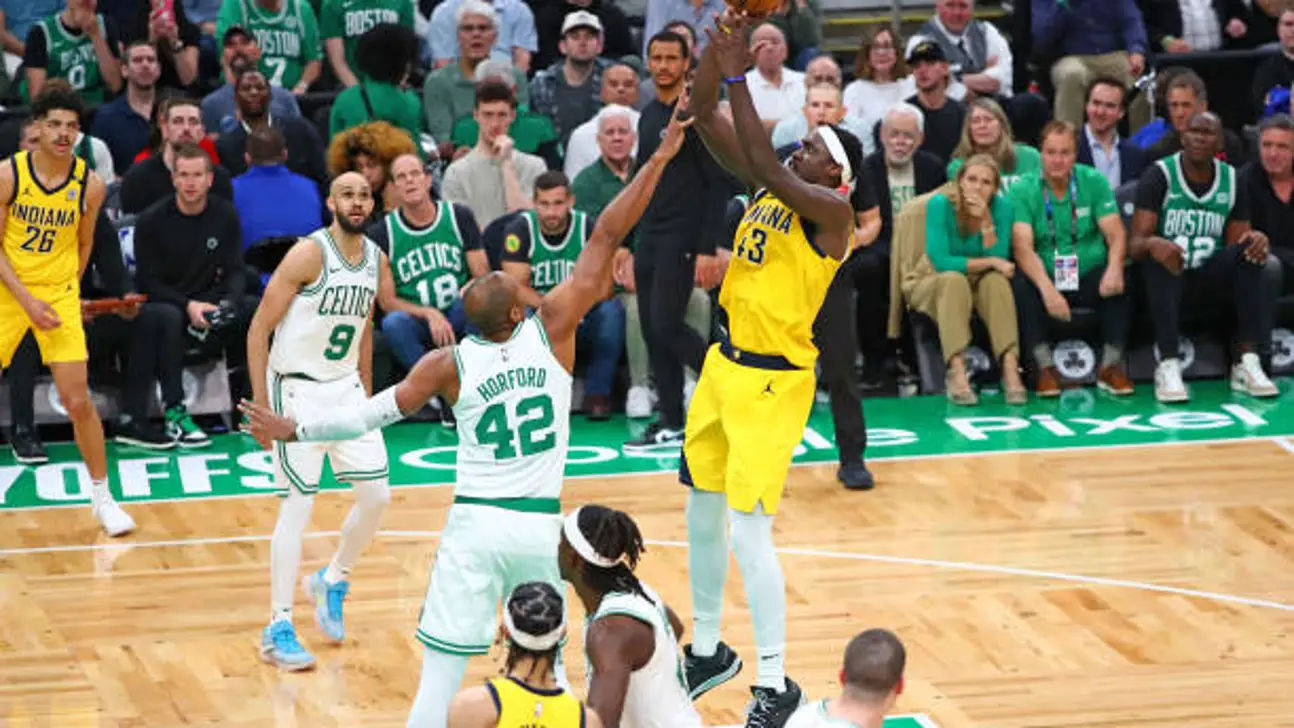In the world of sports, the rivalry between West vs East Match Player Stats teams often produces thrilling matches that captivate fans and highlight the diverse strengths of players. Whether it’s basketball, football, or any other major league, the stats from these intense encounters provide deep insights into individual performances, team dynamics, and how geographical style differences influence outcomes. Let’s delve into how player stats shape this iconic East vs. West rivalry.
Offensive Mastery: East vs West
In basketball, for instance, West vs East Match Player Stats Conference teams often exhibit a fast-paced, high-scoring approach. Teams from cities like Los Angeles, Phoenix, or Denver bring explosive offensive talent, leading to higher field goal percentages and more points per game. Key players in the West tend to dominate with flashy plays, rapid transitions, and a reliance on three-point shooting.
On the other hand, Eastern Conference teams are known for their grit and defensive prowess. Although the East produces lower-scoring games on average, the focus on defensive stats like blocks, steals, and rebounds stands out. Players from cities like Miami, Boston, or New York bring a more physical brand of play, leading to a different set of stats—fewer points but better defensive numbers.
Shooting Stats
When comparing shooting stats between West vs East Match Player Stats, the difference in style is clear. Western Conference players typically lead the league in three-point attempts and percentage. Stars like Stephen Curry and Damian Lillard showcase the West’s emphasis on long-range shooting, consistently posting higher three-point field goal percentages than their Eastern counterparts.
In the East, shooting stats lean more towards mid-range efficiency and driving to the basket. Players like Giannis Antetokounmpo and Jayson Tatum highlight a more traditional scoring approach. Their stats are built around strong field goal percentages within the paint and free-throw efficiency, making them dominant forces in close-range scoring.
Defensive Stats
In the battle of defense, the East often prevails. West vs East Match Player Stats Conference players tend to have higher defensive ratings, averaging more blocks and steals per game. Stars like Bam Adebayo, Joel Embiid, and Marcus Smart are defensive anchors for their teams, with stats that show their ability to disrupt offenses. Defensive rebounding also plays a significant role, as Eastern teams often focus on controlling the glass to prevent second-chance points.
In contrast, the West may prioritize offense, but there are still defensive standouts like Rudy Gobert and Draymond Green, whose stats show their dominance in protecting the rim and guarding multiple positions. However, the overall defensive stats, especially in matchups between East and West, often favor the grittier defensive focus of the Eastern Conference.
All-Star Matchups: Statistical Breakdown
In annual All-Star games, where West vs East Match Player Stats meet in a friendly yet competitive setting, player stats can provide a clear picture of how these two regions stack up. Historically, the West has outscored the East in most All-Star games, with stats showing higher points per game and a tendency to dominate in three-point shooting. However, the East often makes up for it with strong rebounding stats and assists, reflecting a more team-oriented approach.
Looking at individual West vs East Match Player Stats stats in these matchups, superstars from the West like LeBron James and Kevin Durant have consistently led in scoring and assists. Meanwhile, Eastern players such as Giannis Antetokounmpo have posted impressive rebounding and defensive stats, showing the different strengths of players from each conference.
Historical Trends in Player Stats
Over the years, the evolution of the West vs East Match Player Stats rivalry has been marked by distinct shifts in player stats and strategies. Historically, Western Conference teams have dominated fast-break points and three-pointers, particularly during the rise of the “pace and space” era in the 2010s, led by teams like the Golden State Warriors. This revolutionized player stats, where guards and forwards alike saw an increase in three-point attempts, assists, and fast-break points per game.
Meanwhile, Eastern Conference teams have largely maintained their traditional reliance on defense and inside scoring. This approach can be seen in the stats of legendary West vs East Match Player Stats like Tim Duncan, Dwight Howard, and Shaquille O’Neal, whose dominance in points in the paint and blocks per game set them apart. The East’s emphasis on controlling the pace and utilizing the post-game has produced more defensive and rebounding standouts, keeping this region’s playstyle distinct.
The Influence of Superstars
 Superstar West vs East Match Player Stats have a huge impact on how player stats reflect the strengths of their respective conferences. In the West, guards and wings like Stephen Curry, Luka Dončić, and LeBron James have redefined the way stats like assists, three-pointers made, and even rebounds are viewed. These players’ versatility has led to a more dynamic spread of offensive statistics, with many players excelling in multiple categories.
Superstar West vs East Match Player Stats have a huge impact on how player stats reflect the strengths of their respective conferences. In the West, guards and wings like Stephen Curry, Luka Dončić, and LeBron James have redefined the way stats like assists, three-pointers made, and even rebounds are viewed. These players’ versatility has led to a more dynamic spread of offensive statistics, with many players excelling in multiple categories.
In the East, players like Giannis Antetokounmpo and Joel Embiid are leading a resurgence in traditional power basketball. Their stats often show domination in categories like points in the paint, free-throw attempts, and defensive blocks, making them the central figures in their teams’ offensive and defensive strategies. The East, though traditionally seen as defense-first, now has players posting offensive stats that rival the West’s best.
Emerging Trends in Player Stats
As the game evolves, so do the statistical trends that define the West vs East Match Player Stats rivalry. Advanced metrics such as player efficiency rating (PER), win shares, and usage rate now provide a deeper understanding of individual performances beyond traditional stats like points, rebounds, and assists. These advanced stats often highlight the impact of players who may not score the most points but contribute significantly through defense, passing, and overall team play.
In recent seasons, both conferences have seen an increase in “positionless” players, leading to statistical anomalies. For instance, centers like Nikola Jokić in the West are recording high assists and triple-doubles, a stat line traditionally dominated by guards. Meanwhile, in the East, forward-guards like Jayson Tatum are posting elite defensive stats while being top scorers. These changes show how modern basketball blurs the lines between traditional positions, creating more dynamic player stat profiles.
How Stats Shape Team Rivalries
West vs East Match Player Stats play a crucial role in shaping the narratives around team rivalries within and between conferences. The Los Angeles Lakers vs. Boston Celtics rivalry, for example, is as much about player stat dominance as it is about historical wins. The Lakers’ offensive stats, including scoring and fast-break points, contrast with the Celtics’ defensive rebounds and blocks.
Even in other sports like football or soccer, where West vs East Match Player Stats divisions exist, player stats such as yards per game, interceptions, or goals scored often reflect regional styles of play. These stats fuel the intensity of the rivalry, making each matchup a highly anticipated contest not just for the teams, but for individual player comparisons as well.
The Future of East vs. West Player Stats
As both conferences continue to evolve their playstyles, the gap between West vs East Match Player Stats might narrow. The influence of analytics has already begun to reshape how teams in both conferences strategize. For example, Eastern teams are increasingly adopting West-style spacing and three-point shooting, as evidenced by the rise of players like Trae Young and Tyrese Haliburton. Similarly, Western teams are placing more emphasis on defense, driven by players like Anthony Davis and Jaren Jackson Jr., reflecting a convergence of playing styles.
At the same time, the influx of international talent is redefining what it means to be an Eastern or Western player. Global stars like Luka Dončić and Giannis Antetokounmpo have brought a blend of finesse, versatility, and physicality, contributing to a more balanced distribution of player stats across the league. This shift suggests that while the East vs. West rivalry remains strong, the differences in player stats will continue to evolve, making future matchups even more unpredictable and exciting.
Conclusion
The West vs East Match Player Stats rivalry is not just about wins and losses; it’s deeply embedded in player stats that reflect the essence of how each conference approaches the game. From high-flying offenses in the West to the gritty, defensive play of the East, the stats tell the story of two distinct styles of basketball clashing in epic matchups. As player stats continue to evolve with the modern game, this rivalry will remain one of the most compelling in sports, offering fans not just exciting moments, but a rich statistical narrative that highlights the uniqueness of each conference’s approach to the game.
Also Read: Timberwolves vs Lakers Match Player Stats














Leave a Reply